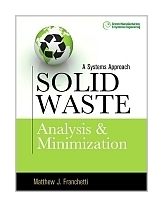Implement successful solid waste analysis and minimization strategies
Provide sustainable solutions to solid waste issues with help from this
hands-on guide.
Solid Waste Analysis and Minimization: A Systems Approach offers
up-to-date technical details on current and potential solid waste minimization practices.
This authoritative resource presents a framework for the proper application of
solid waste analysis tools, and demonstrates the benefits in terms of environmental
impact, process efficiencies, and financial enhancement. Twenty-one real-world case
studies covering all industries, from manufacturing to service facilities, are included.
Solid Waste Analysis and Minimization: A Systems Approach covers:
- U.S. and international waste generation rates
- Industrial ecology, solid waste exchanges, and recycling
- Environmental, economic, corporate image, personal, and social benefits of
solid waste management and minimization
- Solid waste assessment strategies and launch plans
- The Six Sigma systems approach for deployment
- Metrics and performance measurement for solid waste management
- Documentation and development of the deployment plan
- Implementation and execution of the solid waste minimization plan
- Communicating and leveraging success
- Solid waste modeling, research, and data collection
- Characterization by business activities
- Estimation, prediction, and evaluation
Matthew J. Franchetti is currently an assistant professor of Mechanical,
Industrial, and Manufacturing Engineering and director of undergraduate studies of the
Mechanical and Industrial Engineering Programs at The University of Toledo.
Table of Contents
Preface
Part 1. Why Solid Waste Reduction
Ch 1. Definition of Solid Waste Analysis and Minimization
Ch 2. Background and Fundamentals of Solid Waste Analysis and Minimization
Ch 3. Benefits of Solid Waste Analysis and Minimization
Part 2. Solid Waste Assessment Strategies
Ch 4. Deployment Alternatives
Ch 5. Creating a Successful Solid Waste Minimization Launch
Ch 6. The Six Sigma Systems Approach for Deployment
Ch 7. Metrics and Performance Measurement for Solid Waste Management
Ch 8. The General Procedure for a Solid Waste Assessment
Ch 9. Training and Implementation
Ch 10. Communicating and Leveraging Success
Ch 11. The Role of Creativity, Invention, and Innovation in Solid Waste Minimization
Part 3. Solid Waste Generation Modeling: Characterization, Prediction, and
Evaluation
Ch 12. Introduction
Ch 13. Research Methodology
Ch 14. Data Collection
Ch 15. Solid Waste Characterization by Business Activities
Ch 16. Solid Waste Estimation and Prediction
Ch 17. Benchmarking and Evaluation
Ch 18. Model Development and Integration
Ch 19. Model Validation and Case Study Application
Ch 20. Model Summary and Recommendations for Future Research
Part 4. Case Studies
Ch 21. Introduction to Case Studies
Ch 22. Agricultural, Forestry, and Fishing Applications
Ch 23. Mining Applications
Ch 24. Construction Applications
Ch 25. Food and Kindred Product Manufacturing Applications
Ch 26. Apparel- and Fabric-Manufacturing Applications
Ch 27. Wood- and Lumber-Manufacturing Applications
Ch 28. Paper-Manufacturing Applications
Ch 29. Printing and PublishingApplications
Ch 30. Chemical and Petroleum Processing Applications
Ch 31. Plastic and Rubber Manufacturing
Ch 32. Primary and Fabricated Metal Industries
Ch 33. Electronics, Semiconductors, and Other Electrical Equipment
Ch 34. Industrial and Commercial Machinery Including Automotive Manufacturing
Ch 35. Transportation, Logistical, and Warehousing Applications
Ch 36. Health Systems Applications
Ch 37. Commercial, Retail, Financial, and Government Office Applications
Ch 38. Accommodations and Food Service Applications
Ch 39. Automotive Service Applications
Ch 40. Education Applications
Ch 41. International Manufacturing Applications
Ch 42. International Service Applications
References
Index
564 pages, Hardcover
Księgarnia nie działa. Nie odpowiadamy na pytania i nie realizujemy zamówien. Do odwolania !.


